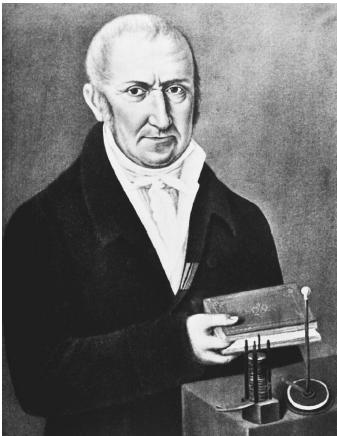Alessandro Volta
ITALIAN PHYSICIST
1745–1827
Until the late 1700s static electricity was the only known form of electricity. Alessandro Volta, born in Como, Italy, is best known for discovering current electricity and for developing the voltaic pile, which became an invaluable tool in electrochemistry.
Volta was interested in electricity early in his career. He published his first book on static electricity at the age of twenty-four. In 1775, Volta announced the discovery of the electrophorus, a new sort of instrument that could store static electricity. And in 1782, Volta invented another instrument, the condensing electroscope that was an extremely sensitive measuring device capable of detecting the existence of negative charge in water vapor and in the smoke of burning coals.
By this time, Volta was a professor at the University of Pavia in Italy, where he was to teach for forty years. He had a very good reputation among chemists and scientists throughout Europe. Among his correspondents was Luigi Galvani (1737–1798), a fellow Italian scientist. Galvani sent Volta a copy of a pamphlet he had written detailing his latest experiments in 1792. Galvani reported that when a partially dissected frog came into contact with two different metals that were grounded, its muscles flexed and legs twitched. He further reported that there was a relationship between the muscular contraction and the electrical stimulus, which he believed to be proof of the existence of "animal electricity."
Volta at first accepted Galvani's explanation of animal electricity as the reason for the frog's involuntary movements. But after carefully repeating Galvani's experiments, Volta became convinced that the contractions of the frog's legs did not result from animal electricity but were due to some external electricity caused by the two different metals in an arc coming into contact with the moist frog. He believed that the frog merely assumed the role of a simple and sensitive electroscope.

In addition to repeating Galvani's experiments, Volta noticed some other effects involving dissimilar metals when they come into contact with moist substances. He found that if two different metals touched the tongue and were brought into contact, a bitter taste resulted. And when two metals touched the eye, contact between them created the sensation of light. After all these experiments, Volta was soon convinced that the metals not only served as conductors but also generated electricity when they were brought into contact.
By 1794 Volta had completely abandoned Galvani's theories of animal electricity. Instead, he advanced the notion of "metallic electricity" or, in modern terms, current electricity. Through further experimentation, he noticed that the electrical effects between select dissimilar substances became stronger the farther apart they were from one another in the following series: tin, lead, iron, copper, platinum, gold, silver, graphite, and charcoal. Volta also determined that an electrical force was generated when a metal was in contact with a fluid. By putting together these two findings, Volta created the first battery.
Volta found that a current was produced when two different metal disks such as silver and zinc were separated by a moist conductor, such as paper soaked in salt water, and brought into contact by a wire. By stacking a collection of silver-moist paper-zinc units, in effect forming a pile, Volta determined that the current intensified. If someone touched the top of such a "voltaic pile" (as this early battery was called) and put his or her other hand in a dish of salt water that was connected to the bottom metal disk by a strip of metal, that person would feel a continuous, if weak, shock.
Volta made his discovery of the current electricity–generating voltaic pile known to the scientific community by 1800. His invention gave rise to new fields of scientific inquiry, including electrochemistry, electromagnetism, and the modern applications of electricity. The first chemists to use the voltaic pile were William Nicholson and Anthony Carlisle, who built a pile and used it to decompose water. Humphry Davy (1778–1829) used the voltaic pile to decompose many substances, such as potash and soda. Davy was also able to isolate for the first time several elements, including calcium and magnesium, using the voltaic pile.
The voltaic pile also had applications in other fields of science. William Cruikshank discovered the process of electroplating while working with a voltaic pile. Davy constructed the first crude electric light with the pile in 1820.
SEE ALSO Davy, Humphry ; Electrochemistry ; Zinc.
LYDIA S. SCRATCH
Bibliography
Dibner, Bern (1964). Alessandro Volta and the Electric Battery. New York: Watts.
Ihde, Aaron John (1984). The Development of Modern Chemistry. New York: Dover.
Internet Resources
"Alessandro Volta." Pavia Project Physics. Available from http://ppp.unipv.it/Volta .
Comment about this article, ask questions, or add new information about this topic: